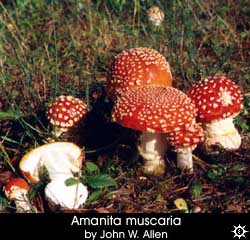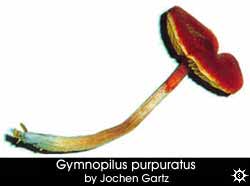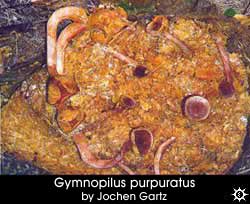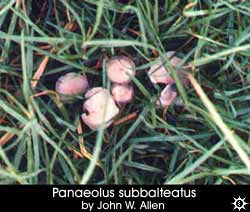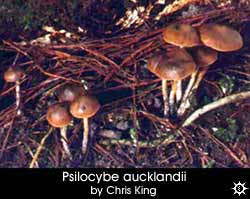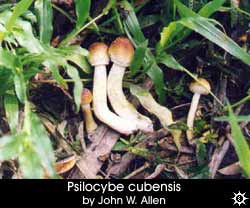
|

TABLE I:
SUSPECTED SPECIES WHICH ARE NOT PSYCHOACTIVE
- 1. Panaeolina foenisecii (Pers. ex Fr.) R. Maire
- Documented Locations: Campbelltown, an eastern suburb of Adelaide, South Australia, Pemberton, Western Australia; Sydney, New South Wales, and now identified from Blackbutt, Queensland. According to Dr. Gastón Guzmán, "this species is probably not hallucinogenic" (see Allen & Merlin 1992c). This has also been confirmed by Stijve (l989, Pers. Comm.), Watling (l989, Pers. Comm.), and Young (l989, Pers. Comm.). It is a common lawn inhabiting species with a cosmopolitan distribution. In New Zealand, P. foenisecii has a cosmopolitan distribution in pasture land (see Allen & Merlin 1992c).
- 2. Panaeolus antillarum (Fr.) Dennis
- Documented Locations: Northern Rivers of New South Wales around Murwillumbah, Eudlo, Queensland; from Victoria, New South Wales, and South Australia. This dung inhabiting species which some authors have mentioned as containing psilocybine does not. However, it does resemble some species of Copelandia and has been known to fruit from the same manure heap as Copelandia sp. It is also the infamous "hysteria fungus" which was reported as a toxic fungi but is not really hallucinogenic.
- 3. Psilocybe collybioides Singer & Smith
- Documented Locations: Queensland; Hobart, Tasmania. Although it is mentioned as occurring in Australia and Tasmania, this species only occurs in Argentina where it appears gregariously on humus or small sticks or leaves and debris on soil. The identification of this species in Australia seems to be inexact. It is possible that this species is similar to or may be one of the three new identified species Psilocybe australiana, Psilocybe eucalypta or Psilocybe tasmaniana.
- 4. Psilocybe coprophila (Bull. ex Fr.) Kummer
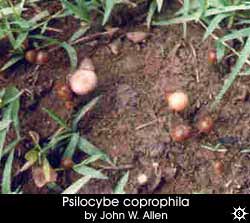
- Documented Locations: Throughout pastures in Australia, appearing infrequently in the dung of horses and cattle. This species is cosmopolitan in its distribution but does not contained any psilocybin, However, it is suspected that it most likely did contain some kind of toxic substance. In New Zealand, a species which may be P. coprophila occurs abundantly in association with rotting Macrocarpa tree stumps and woodpiles at the pony club adjacent to Frankley Road School, New Plymouth. According to Dr. Karl L. R. Jansen, the mushroom which occurs at this site is definitely hallucinogenic (Jansen l989, Pers. Comm.).
TABLE II:
HALLUCINOGENIC FUNGI IDENTIFIED FROM AUSTRALIA AND NEW ZEALAND
- 1. Amanita muscaria (L. ex Fr.) Hooker
- Documented Locations: This species is common in Australia and in New Zealand it is largely confined to stands of pine trees.
- 2. Copelandia cyanescens (Berk. & Br.) Singer
- Documented Locations: Darwin, Northern Territory, New South Wales, Brisbane, Qld; Coffs Harbour and Sydney, New South Wales, Tasmania; and Auckland, New Zealand. This species has a cosmopolitan distribution and occurs in the tropics and neotropics of both hemispheres. This species has 11 binomials (excluding Copelandia anomalus. Common in the dung of cows, water buffalo and sometimes horses. In New Zealand, this species is mainly found on the west coast of the North Island in the New Plymouth area especially in the paddocks near the airport and in the dunes at Khomenii Beach. Also at Whatipu beach near Auckland and some west coast beaches near Wellington (Otaki and Foxton). They tend to occur in the lupin covered zone between pasture and sand. The New Plymouth lupins have recently been decimated by disease and the effect upon fungal growth has yet to be determined.
- 3. Gymnopilus spectabilis (Fr.) Smith (=G. junonius (Fr.) Orton
- Documented Locations: Victoria; Australia. Because this species is very bitter and has a most foul and acrid taste, and requires an alleged dosage of at least 4 to 8 fresh ounces (112-224 gm) of mushrooms for its desired psychotropic effects, it is unlikely that this species is collected in Australia. This species can be found fruiting on dead tree stumps. According to several mycologists, this Australian species is probably Subs. G. pampeanus but recent classification now describes this species as G. junonius and is widespread, at least in NSW, Qld, SA, and Victoria. According to some experts, this species is not psychoactive and various other species of psychoactive Gymnopilus may have been misidentified as G. spectabilis. See next entry on Gymnopilus purpuratus.
- 4. Gymnopilus Purpuratus (Cooke & Masse) Singer
- Documented Locations: Port Lincoln and Big Swamp, South Australia; Victoria, and Western Australia. This species was first identified from Australia by mycologist John Burton Cleland as Flammula Purpurata (derived from the Latin Purpuratus, clad in purple). Cleland described this species as being found on fallen trunks of wood. Gymnopilus purpuratus is an agaric identified from the austral floral zone and was first collected in Chile. This species blues easily, taste very bitter and is probably hallucinogenic. 1992 chemical analysis of collections from Germany by Dr. Jochen Gartz of the University of Leipzig and others have demonstrated high levels of psilocin and low levels of baeocystin. Dr. Gartz reported that "since 1983, this species has been observed on heaps of pig dung and woodchips in the district Rostock, Northern G. D. R. (East Germany). It seems that this species was introduced (into Germany) with grain from Argentina used for pig forage." Gartz also noted that this species stains blue when handled and was found to be exempt of other tryptamines, muscarine, and urea. Recently, this species was reported by Australian mycologists Shepherd and Totterdell (1990) as gregarious on rotted wood.
- 5. Panaeolus subbalteatus (Berk. & Br.) Sacc.
- Documented Locations: Throughout Australia. In 1973, Shepherd and Hall reported that Panaeolus papilionaceus (which is also psilocybian) occurred in South Australia, Victoria, and Queensland, and noted that Panaeolus subbalteatus was collected in New South Wales. According to one mycologist, the presence of P. papilionaceus in Australia has not been confirmed. This species has a cosmopolitan distribution, appearing infrequently in both the northern and southern hemispheres. It is common in the dung of cattle; also fruiting abundantly in composting and rotting hay, haystacks, stable shavings at race tracks and riding stables, and is sometimes known to occur in lawns.
- 6. Psilocybe aucklandii Guzmán, King & Bandala.
- Documented Locations: In New Zealand, 25 km north of Auckland, Wood Hill State Park. Gregarious on brown clay soil partially covered with pine needles of Pinus radiata D. Don, in a mixed pine and dicotyledonous native tree forest.
- 7. Psilocybe australiana Guzmán & Watling
- Documented Locations: New South Wales: near Canberra, Cotterdam, Blue Mountains west of Sydney; Tidbinbilla Nature Reserve; near Sydney, Mt. Wilson. Gregarious on soil with wood or leafy debris, on tracks and roadsides, in Pinus radiata plantations, or in temperate rain forests. Known only from around New South Wales in Australia. In New Zealand, 20 km West of Auckland near Oratia. Fruits in April. This species is very similar to P. cyanescens Wakefield.
- 8. Psilocybe cubensis (Earle)
- Documented Locations: Springbrook at 2000 feet elevation. River Brisbane at Indooroopilly, Brisbane, Carboolture, Beechmont, Queensland; and Hobart, Tasmania. Gregarious, rarely solitary or scattered, on cow dung, sometimes on rich pasture soils. Although some recreational users (l989-l989, Pers. Comm.) have reported picking this species in New Zealand, this finding has not been confirmed by others and neither the present author or his colleague Dr. Karl L. R. Jansen nor the DSIR mycology section have ever found P. cubensis growing in New Zealand.
- 9. Psilocybe eucalypta Guzmán & Watling
- Documented Locations: New South Wales: Near Canberra, Tidbinbilla Nature Reserve; near Queanbeyan, Talaganda Forest Reserve; near Sydney, Mt. Wilson. In New Zealand, Northwest of New Plymouth. Solitary on soil or in small groups amongst grassy woody debris, or among mosses in shallow groves of Eucalyptus forests. Fruits in April. This species is similar to P. cyanescens Wakefield.
- 10. Psilocybe kumaenorum Heim
- Documented Locations: New Guinea. While this species is known only from New Guinea, However it is very possible that it could occur in Australia. Gregarious on soil, in small groups, in open places among grasses.
- 11. Psilocybe makarorae Johnston & Buchanan
- Documented Locations: New Zealand at Otago Lakes: Haast Pass, vic. Makarora, Blue Pools Track on rotten Nothofagus wood. Also found at Bay Of Plenty: vic. Rotorua, Mt. Ngongotaha on fallen wood; Westland: Franz Josef Glacier moraine on fallen twigs; at Peter's Pool Track on litter and in Dunedin: vic. Dunedin City, Woodside Glen picnic ground on rotting Wood.
- 12. Psilocybe semilanceata (Fr. ex Secr.) Kummer
- Documented Locations: Australia; Mt. Field National Park, Tasmania. This mushroom was first reported from Australia in 1892. It was next reported from New South Wales in 1895. In l974, it was documented from Victoria, and that same year, specimens were collected in Tasmania. Although this species is very common, well known, and much prized by recreational mushroom enthusiast throughout Europe, Scandinavia, Great Britain, Canada; the Pacific Northwest region of the United States and South America, no reports of its suspected use as a recreational drug in Australia existed until only recently. It is very probable though that this species is known and used by members of the drug subculture in Australia, however, no published reports exist which indicate that this species has ever been confiscated by narcotic officers on the continent or its suspected use been brought to their attention. Very scattered to gregarious on rich soil, among grass in pastures and meadows. Single but very rarely caespitose. Frequently abundant around clumps of tall grass. Lawns, parks and playgrounds. In New Zealand, this species appears largely confined to the south of Cook Island, in particular the Otago Peninsula and Mount Cook in soil in high-altitude grasslands and has been observed in Mackenzie: vic. Mt. Cook, Otago Lakes and in the vicinity of Queenstown. Has been used recreationally since the early l980's. There is a specimen in the DSIR collection which was found on a suburban lawn in Auckland; also collected Southeast of Wakefield, Inangahua Junction.
- 13. Psilocybe subaeruginosa Cleland
- Documented Locations: Cleland (1927) first reported this species from South Australia, New South Wales and Victoria. Other reported locations include: Adelaide, Adelaide Hills, Mt. Lofty, South Australia; Australian Capital Territory; National Park, Belair, Mt. Field National Park, Tasmania. On pathway to Russell Falls. Fruiting on horse dung during the summer (April-August) months. Solitary to gregarious, on rich soil among grass or horse dung, or on decaying leaves and twigs, mainly in deeply shaded places. Johnston and In 1995, this species was reported from New Zealand at Auckland, Waikato, Bay of Plenty, Taranaki, Wanganui, Nelson, Buller, Southland as being common on small pieces of buried wood on rough coastal farmlands and pastures and especially on sandy soil, and in gardens, especially on mulches of Pinus radiata bark. The presence of psilocybine in this species in Australia was detected in 1970 and three years later, Dr. Malcomb Hall reported its use as a recreational drug.
- 14. Psilocybe subcubensis Guzmán
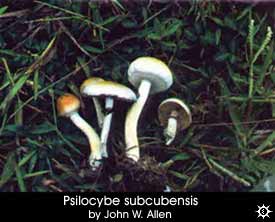
- Documented Locations: Throughout Australia. Appearing abundantly after heavy rains in Queensland, Breban, and near Loboutluse. This species is only distinguishable from Psilocybe cubensis by the size of its spores. Scattered on cow dung, more rare in rich soil, in grassy places (pastures). It is a pantropical and subtropical species. Fruiting in summer but also in other seasons.
- 15. Psilocybe tasmaniana Guzmán & Watling
- Documented Locations: New South Wales; near Canberra, Tidbinbilla Nature Reserve. Tasmania: NE of Hobart, Nugent, Buckland, Mt. Field National Park. Solitary or in small groups on dung, or at least on debris (wood and leaves), intermixed with dung (sometimes kangaroo). Fruits in April and May. This species was also collected from Mt. Field National Park (in grassy area under trees with P. semilanceata. This species is closely related to P. subaeruginosa, but is somewhat similar to P. cyanescens. This species has also been collected in the New Plymouth area of New Zealand.
- 16. Unidentified Species
- Documented Locations: Unidentified species have been collected from the Waitakere Ranges, growing in native forest near Auckland, and on the west coast of the South Island. Dr. Karl L. R. Jansen (l989, Pers. Comm.) reports that there are at least 5 unidentified species from New Zealand which are considered psychoactive. In 1981 there was a report of an unidentified bluing Psilocybe sp.,. with affinities to the North American species Psilocybe caerulipes from New Zealand.
TABLE III:
SPECIES IN AUSTRALIA, TASMANIA, AND NEW ZEALAND
AUSTRALASIA
- In Most States
- Psilocybe cubensis (Earle) Singer.
- Australian Capital Territory
- Psilocybe subaeruginosa Cleland.
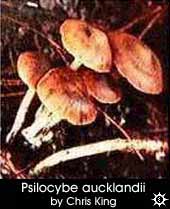
- New South Wales
- Psilocybe aucklandii Guzmán, King & Bandala.
- Psilocybe australiana Guzmán & Watling.
- Psilocybe eucalypta Guzmán & Watling.
- Psilocybe semilanceata (Fr.:Secr.) P. Kumm.
- Psilocybe subaeruginosa Cleland
- Psilocybe tasmaniana Guzmán & Watling.
- Panaeolus subbalteatus (Bk. & Br.) Sacc.
- Copelandia cyanescens (Bk. & Br.) Singer.
- Gymnopilus Junonius (Fr.) Orton= syn.
- Gymnopilus spectabilis (Fr.).
- Northern Territory
- Copelandia cyanescens (Bk. & Br.) Singer.
- Queensland
- Psilocybe cubensis (Earle) Singer.
- Psilocybe subcubensis Guzmán.
- Copelandia cyanescens (Bk. & Br.) Singer
- [=Panaeolus cyanescens (Bk. & Br.) Sacc.].
- Gymnopilus Junonius (Fr.) Orton= syn.
- Gymnopilus spectabilis (Fr.) A. H. Sm.
- South Australia
- Psilocybe subaeruginosa Cleland.
- Copelandia cyanescens (Bk. & Br.) Singer
- Gymnopilus Junonius (Fr.) Orton=syn.
- Gymnopilus spectabilis (Fr.) A. H. Sm.
- Gymnopilus purpuratus (Cooke & Masse) Singer.
- Victoria
- Psilocybe semilanceata (Fr.:Secr.) P. Kumm.
- Psilocybe subaeruginosa Cleland.
- Panaeolus ater (Lange) Kuhner & Romagnesi ex Bon.
- Gymnopilus purpuratus (Cooke & Masse) Singer.
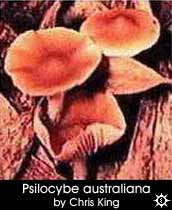
- Western Australia
- Gymnopilus purpuratus (Cooke & Masse) Singer.
TASMANIA
-
- Psilocybe australiana Guzmán & Watling .
- Psilocybe cubensis (Earle) Singer.
- Psilocybe semilanceata (Fr.:Secr.) P. Kumm.
- Psilocybe subaeruginosa Cleland.
- Psilocybe tasmaniana Guzmán & Watling
- Copelandia cyanescens (Bk. & Br.) Singer
NEW ZEALAND

- Auckland
- Psilocybe aucklandii Guzmán, King & Bandala.
- Psilocybe semilanceata (Fr.:Secr.) P. Kumm.
- Copelandia cyanescens (Bk. & Br.) Singer.
- North Island
- Psilocybe aucklandii Guzmán, King & Bandala
- Psilocybe australiana Guzmán & Watling.
- Psilocybe eucalypta Guzmán & Watling
- Psilocybe subaeruginosa Cleland.
- Psilocybe tasmaniana Guzmán & Watling.
- South Island
- Psilocybe makarorae Johnston & Buchanan.
- Psilocybe semilanceata (Fr.:Secr) P. Kumm.
- Psilocybe subaeruginosa Cleland.
ACKNOWLEDGEMENTS
The author of this guide expresses his gratitude to the following for their contribution to this paper: Dr. R. V. Southcott for providing case histories from Australia, and for supplying photographs of P. subaeruginosa; Dr. A. E. Stocks of the Brisbane Clinic; Dr. Malcolm C. Hall, General Manager of Vision Systems, Adelaide; Julie Shepherd of the National Library of Australia, Canberra, A.C.T.; Elizabeth Duncan, Secretary to the Editor of the Sunday Telegraph, Sydney; Crispin Hull, Editor of the Canberra Times, A.C.T.; The Librarian of the Biomedical Library, University of New South Wales; Field Naturalist Club of Victoria, South Australia; The Flora and Fauna of South Australian Handbooks Committee; Rob Hincksman of the Australian Government Publishing Service; J.A. Pitt, New South Wales Government, Department of Agriculture; Gretina Norton, Administrative Assistant of the Medical Journal of Australia; Eric J. Curtis, Laiason Officer of the Australian Federal Police in Honolulu; Dr. Peter Buchanan and Dr. Peter Johnson of the Auckland D.S.I.R.; Detective Sergeant John Dearing of the Auckland Drug Squad. A specieal note of appreciation to Chris King of the University of Auckland for the use of his photographs of Psilocybe aucklandii, Psilocybe australiana and one unidentified species from New Zealand. The author also expresses his gratitude to Dr. Gaston Guzmán of the Instituto De Ecologia, A.C., Mexico, D.-F., and A. M. Young of Australia for their valuable assistance in reviewing the identification of species section; Dr. Mark D. Merlin of the University of Hawaii for his time and help in reviewing and editing this booklet for publication; Dr. Karl L. R. Jansen for editing and providing the section on New Zealand, who along with Dr. Rick Strassman of the University of New Mexico, Dr. Stanley Krippner of the Saybrook Institute and Dr. William Emboden of the California State University at Northridge reviewed the final manuscript; and a special note of gratitude to Dr. Roy Watling of the Royal Botanic Society of Edinburgh, Scotland, for his time and consideration in reviewing this manuscript prior to publication.
SUGGESTED READING
Aberdeen, J. E. C. and W. Jones. 1958. A hallucinogenic toadstool. Australian Journal of Science vol. 21:149. December 21.
Allen, J. W. l988. A Private Inquiry into the Circumstances Surrounding the l972 Death of John Gomilla, Jr., Who Died After Allegedly Consuming l0 Magic Mushrooms While Residing in Hawaii. Journal of Psychoactive Drugs. 20(4):451-454.
Allen, J. W. 1997a. Magic Mushrooms of the Pacific Northwest. Psilly Publ. and RaverBooks. Seattle.
Allen, J. W. 1997b. Teonanácatl: Ancient and Contemporary Shamanic Mushroom Names of Mesoamerica and Other Regions of the world. Ethnomycological Journals Sacred Mushroom Studies. vol. IV:1-48.
Allen, J. W. and M. D. Merlin. 1992. Observations Regarding the Suspected Psychoactive Properties of Panaeolina foenisecii Maire. Yearbook for Ethnomedicine and the Study of Consciousness. vol 1:99-115.
Allen, J. W., Merlin, M. D. and K. L. R. Jansen. 1991. An Ethnomycological Review of Psychoactive Agarics in Australia and New Zealand. Journal of Psychoactive Drugs. vol. 23(1):39-69.
Australian Government Publishing Service. l980. Hallucinogenic Mushrooms. Australian Royal Commission of Inquiry into Drugs. A:67, l86.
Cleland, J. B. l934. Toadstools and Mushrooms and other Larger Fungi of South Australia:l9. Adelaide, Australia.
Cribb, A. B., and J. W. Cribb. l975. Psilocybe cubensis. Wild Foods of Australia:209. Adelaide, Australia.
Guzmán, G. l983. The Genus Psilocybe: A Systematic Revision of the Known Species Including the History, Distribution and Chemistry of the Hallucinogenic Species. Beihefte zur Nova Hedwigia vol. 74. J. Cramer. Valduz, Germany.
Guzmán, G. 1995. Supplement to the monograph of the genus Psilocybe. In: O. Petrini & E. Horak, Taxonomic Monographs of Agaricales. Bibliotheca Mycologica vol. 159:91-141. Berlin-Stuttgart. Cramer.
Guzmán, G. and R. Watling. l978. Studies in Australian Agarics and Boletes. l. Some Species of Psilocybe. Notes from the Royal Botanic Garden 36:179-210. Edinburgh, Scotland.
Guzmán, G., Bandala, V. M. and C. King. 1991. A new Species of Psilocybe of section Zapotecorum from New Zealand. Mycological Research. vol. 95:507-508.
Guzmán, G., Bandala, V. M. and C. King. 1993. Further Observations on the genus Psilocybe from New Zealand. Mycotaxon. vol. XLVI:161-170.
Guzmán, G., Allen, J.W. and J. Gartz. 1999. A Worldwide Geographical Distribution of the Neurotropic Fungi, Analysis and Discussion. And. Civ. Mus. Rovereto, (in press)
Guzmán, Gaston., Jonathan Ott, Jerry Boydston and Steven H. Pollock. l976. Psychotropic Mycoflora of Washington, Idaho, Oregon, California, and British Columbia. Mycologia. Vol.68 (6): 1267-1271.
Hailstone, B. l972. Many Taking a Trip on Hills Mushroom. The Advertiser. August 11. Adelaide, Australia.
Hall, M. C. l973. Problems in Legislating Against Abuse of Hallucinogenic Fungi in Australia. U. N. Bulletin on Narcotics 25:27-36. A United Nations Publication.
Hofmann, A. 1980. LSD: My Problem Child. McGraw-Hill. New York.
Hollister, L. E., Prusmark, J. J., Paulsen, J. A., and N. Rosenquist. l960. Comparison of Three Psychotropic Drugs, Psilocybin, IT-290, and JB-329. Journal of Nervous and Mental Diseases. Vol. 131 (5):428-434.
Jansen, K. L. R. l988. Magic Mushrooms: a Fast Growing Problem. Journal of General Practice. 5:7-10.
Johnston, P. R. and P. K. Buchanan. 1995. Thye genus Psilocybe (Agaricales) in New Zealand. New Zealand Journal of Botany. vol. 33(3):379-388.
------. l989. Personal Communication, April 26 and August 17, l989.
Lincoff, Gary and D. H. Mitchell. l977. Toxic and Hallucinogenic Mushroom Poisoning. Van Nostrand Reinhold, N. Y.
McCarthy, J. P. l971. Some Less Familiar Drugs of Abuse. Medical Journal of Australia. 12(21):1078-1081.
McRoach, J.J. l979. A Dozen Dopey Yarns: Tales from the Pot Prohibition. Australian Marijuana Party, Victoria, Australia, p70.
Margot, P., and R. Watling. l981. Studies in Australian Agarics and Boletes. 2. Further Studies in Psilocybes. Trans. of the Brit. Mycol. Soc. 76(3):485-489.
Misuse of Drugs Act. l975. No. 116:3. Government Printer, Wellington, NZ.
O'Neill, G. l986. Deadly Mushrooms in Profusion After Rain. Canberra Times.
Ott, J. l976, Hallucinogenic Plants of North America. Wingbow Press. Berkeley, Ca.
Ott, J. 1993. Pharmacotheon. Natural Products. Kenniwick, Washington.
Pegler, D.N. l965. Studies on Australasian Agaricales. Australian Journal of Botany. 13(2):323-356.
Picker, J., and R. W. Rickards. l970. The Occurrence of the Psychomimetic Agent Psilocybin in an Australian Agaric, Psilocybe subaeruginosa. Australian Journal of Chemistry. 23(4):853-855.
Perkel, M., Blackman, G. L., Ottrey, A. L. and L. K. Turner. 1980. Determination of Hallucinogenic Components of Psilocybe Mushrooms using High-Performance Liquid Chromatography Journal of Chromatography vol. 196(1):180-184.
Pollock, S. H. l977-l978. Psychotropic Mushrooms and the Alteration of Consciousness. l: The Ascent of Psilocybian Mushroom Consciousness. Journal of Altered States of Consciousness. 3(1):15-35.
Pollock, S. H. l980. Personal Communication.
Rumack, Barry H., and Emanuel Salzman. l978. Mushroom Poisoning: Diagnosis and Treatment. CRC Press, Cleveland.
Shepherd, C. J., and Malcolm C. Hall. l973. Australian Hallucinogenic Fungi-Taxonomic, Pharmacological, and Legal Aspects. Paper read to the Australian and New Zealand Association for the Advancement of Science.
Section 11.5.
Shepherd, C. J. and C. J. Totterdell. 1990. Mushrooms and Toadstools of Australia. Inkata. Melbourne.
Singer, R. l978. Hallucinogenic Mushrooms. In: Rumack and Salzman (Eds.):Mushroom Poisoning: Diagnosis and Treatment. Chap. 12:201-214. CRC Press, Cleveland.
Smith, A. H. l978. Poisonous Mushrooms: Their Habitat, Geographical Distribution, and Physiological Variation Within Species. In: Rumack & Saltzman (Eds.): Mushroom Poisoning: Diagnosis and Treatment. CRC Press, Cleveland.
Southcott, R. V. l974. Notes on Some Poisonings and other Clinical. Effects Following Ingestion of Australian Fungi. South Australian Clinics 6(5):442-478.
Stamets, P. 1996. Psilocybin Mushrooms of the World. Ten Speed Press. Berkeley.
 Stein, Sam I. 1958. An Un Usual Effect from a Species of Mexican Mushrooms, Psilocybe cubensis. Mycopathologia et Mycologia Applicata vo. 9(4):263-267.
Stein, Sam I. 1958. An Un Usual Effect from a Species of Mexican Mushrooms, Psilocybe cubensis. Mycopathologia et Mycologia Applicata vo. 9(4):263-267.
Stocks, A. E. l963. Mushroom Poisoning in Brisbane. Journal of the Princess Alexandra Hospital 1:21-24.
Thompson, John P., M. Douglas Anglin., William Embodden and Dennis Gene Fisher. l985. Mushroom Use by College Students. Journal of Drug Education Vol. 15 (2): 111-124.
Trotter, J. E. l944. A Report of Nine Cases of Mushroom Poisoning. Medical Journal of Australia 1(18):393.
Unsigned. l941. A Poisonous Fungi. Agricultural Gazette of New South Wales. 52(4):213. April 1.
Unsigned. l969a. Broadcast of Psilocybian Mushroom Poisoning. Australian Broadcasting Commission News Item. 7 P. M. June 3. Sydney, New South Wales.
Unsigned. l969b. Sydney Sunday Telegraph. 30:1. June 29.
Unsigned. l969c. The Mushrooms Contained Drugs. Canberra Times:9. July 11.
Unsigned. l969d. Canberra Times:2. July 12.
Unsigned. l970. Hippies Flocking to Mexico for Mushroom Trips. New York Times: 6c. July 23.
Unsigned. l972. High School Fungal Eaters in Brisbane. Daily Telegraph. November 14. Sydney, Australia.
Unsigned. l973. The Pastoral Industries of Australia. (Eds): G. Alexander and O. B. Williams. Sydney University Press, University of Sydney.
Unsigned. l982. Magic Mushroom Danger Warning. Taranaki Herald:9. Wednesday, May 21. NZ.
Unsigned. l986. Debate Sprouts over Fungus. Herald. Oct. 9th. NZ.
Unsigned. l989. Drug Taken for Better Outlook. New Zealand Herald. Aug l1:10.
Wasson, R. G. l957. Seeking the Magic Mushroom. Great Adventures in Life Part I: Mushrooms That Cause Strange Visions. May 13. Life Magazine. International Edition: June 10, l957.
Willis, J. H. l957. Victorian Toadstools and Mushrooms:46. 2nd. Edition. Field Naturalist Club of Victoria.
Young, A. M. l989. Panaeolaiecaie of Australian Fungi. Journal of Australian Systematic Botany (In Ed.).
Young, R., Milropy, R. Hutchinson, S and C. Mikessen. 1982. The Rising Price of Mushrooms. Lancet no. 8265:213-215.
|

 Stein, Sam I. 1958. An Un Usual Effect from a Species of Mexican Mushrooms, Psilocybe cubensis. Mycopathologia et Mycologia Applicata vo. 9(4):263-267.
Stein, Sam I. 1958. An Un Usual Effect from a Species of Mexican Mushrooms, Psilocybe cubensis. Mycopathologia et Mycologia Applicata vo. 9(4):263-267.


